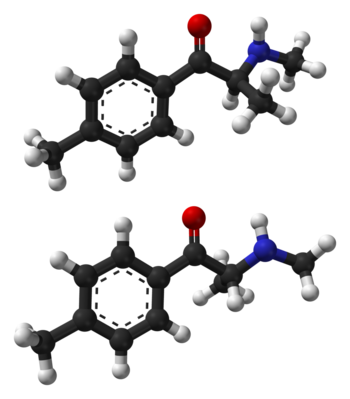In 2009, the synthetic stimulant  mephedrone became a hugely popular recreational drug for young people in the UK while at the same time it was demonised by the media. Although it was eventually made illegal, drug policy and availability will never be the same.
mephedrone became a hugely popular recreational drug for young people in the UK while at the same time it was demonised by the media. Although it was eventually made illegal, drug policy and availability will never be the same.
Mephedrone, like several other stimulant drugs, owes its existence to a naturally occurring plant. Plant-derived stimulants include cocaine, which occurs naturally in leaves of the coca plant, and caffeine, found naturally in the seeds (beans) of the coffee plant. Mephedrone is not itself a natural product but is closely related to compounds found in the leaves of a plant called khat (Catha edulis).
Khat-a natural stimulant plant
Khat is a flowering shrub with evergreen leaves, native to East Africa and the Arabian Peninsula. It is known by many other names including qat, gat, qaat, mirra and Abyssinian tea. It has been consumed for centuries in this part of the world and the stimulant properties were probably known before those of coffee.
Khat users take several fresh leaves and crush them in the mouth, tucking the wad of leaves into the cheek, creating a recognisable bulge. The active chemicals are slowly released from the wad of leaves leading to a state of euphoria and arousal.
Traditionally, khat has been a social drug with its use being similar to those of coffee or alcohol in other cultures. It is also used to combat hunger and physical fatigue and to improve attention. Khat is particularly popular in Yemen, where up to 80% of men and 40% of women chew it regularly.
Although use of khat may be important socially, it is not without its problems. Some of these include a psychological dependence on the drug, loss of appetite, sleeplessness, effects on the cardiovascular system and oral cancers. People may also spend long periods in a semi-intoxicated state to the detriment of family life and work. Disproportionate amounts of household income may be spent on khat leaving insufficient money for food. And because it is so profitable, growing khat now consumes a large proportion of the agricultural resource of Yemen, particularly irrigation water.
The stimulant properties of khat do not last very long once the leaves have been picked, and until recently this restricted its use to areas where the plant grows. However, access to air freight and increased knowledge of the plant has made the leaves available in other parts of the world. And although its use remains illegal in many countries, khat is not illegal in the UK and immigrants from Ethiopia, Somalia and Yemen are the principal users.
What are the active chemicals in khat?
Two active molecules, called cathine and cathinone, have been identified in the fresh leaves of khat and are responsible for its psychoactive effects. Cathinone is the more potent brain stimulant of the two, but is unstable and is converted to the less potent cathine after the leaves are picked, accounting for the loss of stimulant properties. Cathinone has been termed a "natural amphetamine" based on its effects; in fact the two drugs are similar in structure and cathinone is illegal in many countries.
 Cathinone achieves its stimulant effects by altering brain chemistry. Like amphetamine, it increases the release of three compounds in the brain: serotonin, dopamine and noradrenaline. These chemicals, called the "monoamines", are important nervous system signalling molecules used by the brain to control behaviour and emotion.
Cathinone achieves its stimulant effects by altering brain chemistry. Like amphetamine, it increases the release of three compounds in the brain: serotonin, dopamine and noradrenaline. These chemicals, called the "monoamines", are important nervous system signalling molecules used by the brain to control behaviour and emotion.
In recent years scientists have chemically tweaked the basic cathinone structure to produce other behaviour-modifying molecules including some used as prescription drugs, one being bupropion, which works as an antidepressant and can help people quit smoking.
Mephedrone
Mephedrone is related to cathinone but has two molecular tweaks: the addition of two methyl groups (carbon atoms attached to three hydrogen atoms).
Its synthesis had been reported in 1929 but remained an academic curiosity until 2003 when a bored underground chemist, going by the pseudonym of "Kinetic", decided to make mephedrone and ingested some of the product. He posted a report on the internet that this new molecule had stimulant effects similar to those of another popular stimulant drug, ecstasy (MDMA) and the potential of mephedrone was established.
Drugs similar to mephedrone were available in Israel from 2004 but eventually became illegal. From 2007, mephedrone could be purchased from internet-based suppliers, believed to be linked to labs in the Far East.
The rise and fall of mephedrone in the UK
By the summer of 2009, mephedrone (known variously as MCAT, meph, drone, miaow, meow, miaow miaow and meow meow) had become enormously popular with clubbers in the UK. In one survey it was reported to be the fourth most popular street drug.
Such a rise in popularity was unprecedented and arose partly because the quality of two other drugs popular with clubbers, cocaine and ecstasy, had been dropping at the time. Mephedrone provided a legal, relatively pure, alternative that produced psychological effects related to those of cocaine and ecstasy. So, for a short time, mephedrone was a "legal high" that was readily available with no questions asked.
was unprecedented and arose partly because the quality of two other drugs popular with clubbers, cocaine and ecstasy, had been dropping at the time. Mephedrone provided a legal, relatively pure, alternative that produced psychological effects related to those of cocaine and ecstasy. So, for a short time, mephedrone was a "legal high" that was readily available with no questions asked.
The effects of mephedrone include euphoria, increased energy, enhanced appreciation for music, increased empathy and mild sexual stimulation - effects that are popular with clubbers. The drug also causes sweating, increased heart rate, headache, teeth grinding, and some users have required hospitalisation with symptoms including agitation, palpitations, fast and irregular heartbeat and raised blood pressure. Many of these symptoms are due to effects of the drug on the cardiovascular system. Some users have also died.
So what do we know about the biology of mephedrone? Because interest in mephedrone is very recent, little research has been done on how it works. But given its similarities to cathinone, increased release of brain monoamines seems likely.
The long term effects of mephedrone are also unclear so it is too soon to know if it is addictive. The effects of a dose of mephedrone are rather short lived and stop suddenly. This leads to craving and compulsive re-dosing so that users may consume a large quantity of drug in one session, which may increase the potential for harm. Users also seem to find it difficult to stop taking the drug suggesting potential for addiction. No studies have been performed on the toxicity of the drug and its long term ability to cause cancer or birth defects. These uncertainties increase the possible risk to those taking the drug.
The meteoric rise of mephedrone, taking the clubbing scene by storm, piqued the interest of the media, which enthusiastically embraced the story, pumping out regular scare stories about the effects of the drug. Some of these were true, some were not.
There have been several high-profile reports of deaths associated with taking the drug. Some of these have been validated, showing the potential for risk. One report of the deaths of two young men in Scunthorpe, which had great resonance, was initially strongly linked to mephedrone but later it was found that they had not taken mephedrone at all.
Scrotum ripped off...
An example of careless press reporting was a story carrying the headline "Legal drug teen ripped his scrotum off"; this turned out to be based entirely on an internet hoax. The media frenzy surrounding the drug grew, and coupled with political pressure this lead eventually to mephedrone being made illegal in the UK in April 2010. The decision to ban mephedrone was, however, made when very little information about the drug was available.
Despite being an illegal drug, mephedrone is still available via the internet, or through dealers, although, predictably, the price has increased substantially.
In addition, other drugs have appeared on the internet to filled the void left by mephadrone including NRG-1 (naphyrone, now illegal), 2-DPMP and 6-APB. Mislabelling of products is now occurring with some samples of NRG-1 actually containing mephedrone. So, although mephedrone is illegal, there is now a highly unstable situation whereby the drug is still available, but poorly-characterised alternatives are entering the market.
Present state of drug availability and policy in the UK
The story of mephedrone shows how the recreational drug market has changed. Cheap organic synthesis is readily available in labs in Eastern Europe and the Far East and these labs scour the scientific literature for new drugs to make.
These drugs can be publicised and sold on the internet; there is no longer a need for back-street drug dealing.
New substances have not been encountered before so they are often legal when introduced and, for some people, designation of drugs as "legal" means "safe". Once the regulatory authorities catch up and the substance has been made illegal another related compound can be brought forward; a game of cat and mouse is being played between the suppliers and the regulatory authorities.
Purity
What about the purity of the drugs supplied in this way? There are no controls on the labs supplying the drugs, so the purity, although often claimed to be high, is not defined and users may be consuming products of uncertain composition. This problem is compounded by deliberate mislabelling of samples.
Moreover, because these are often new molecules, the psychological and physiological effects are not well known, and no studies have been performed on the long term effects of the drugs. People have taken stimulants for centuries and, despite the risks and their illegal status, they remain extremely popular . We need to acknowledge and understand drug-taking behaviour in order to minimise the potential for harm.
Part of this raised awareness should include research into the effects of drugs, and this is particularly important for mephedrone. Public education should also be used, so that people can make informed decisions and understand any associated risks. For example, the highly addictive nature of cocaine and the presently unknown nature of mephedrone needs to be stressed.
Simply banning drugs is not enough, and it may fuel organised crime and lead to unnecessary criminalisation of users. Science and education must form the bedrock of our approach to recreational drug use.
- Previous CSI Swansea
- Next Sardines: Fish Food or People Food?










Comments
Add a comment